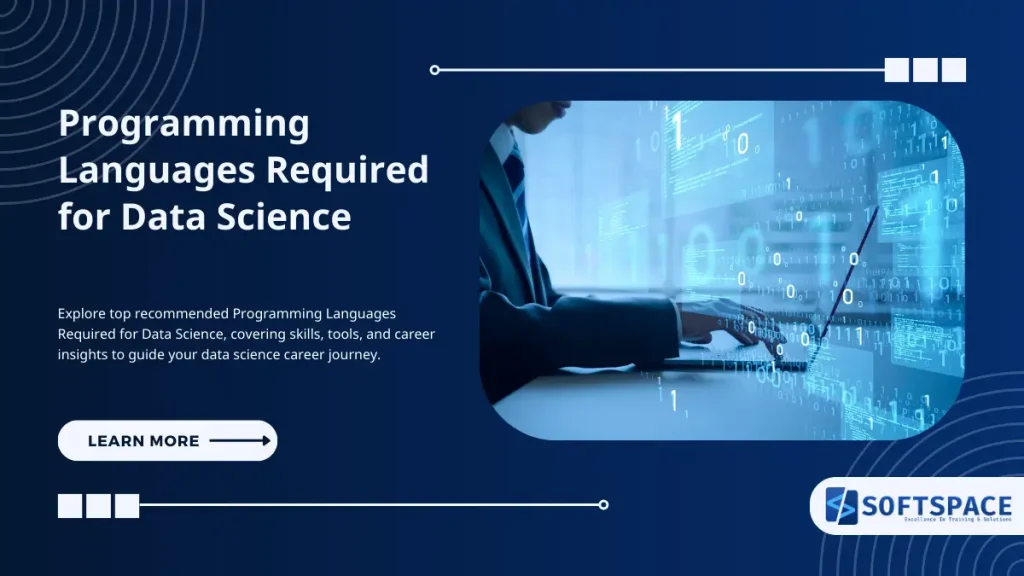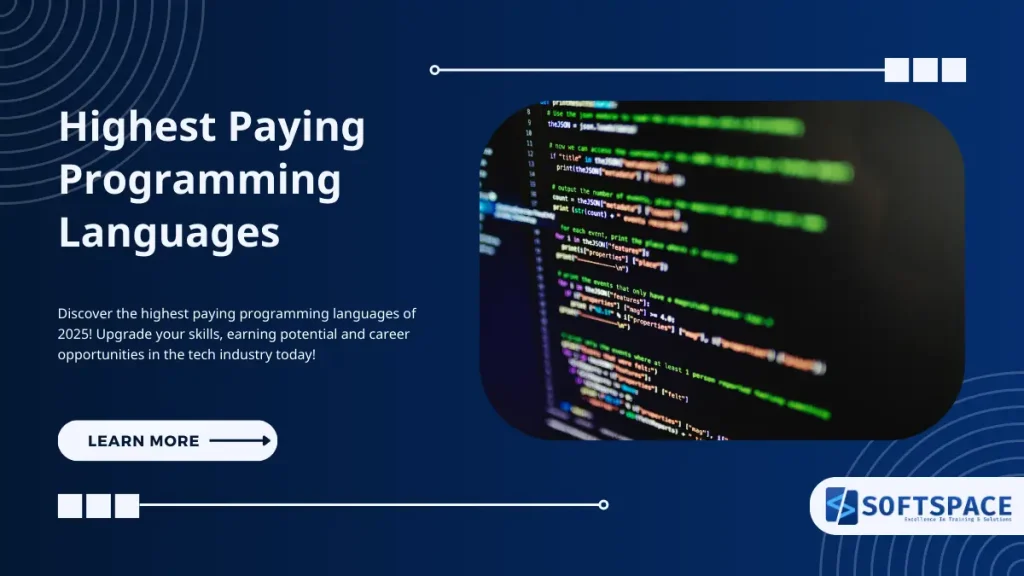Today, in 2025, everyone is thinking of a career in Data Science and related fields. Why? Because it has fantastic opportunities and reimbursements. The scope is expansive, and there are jobs all around the world. So, what exactly do you need to build a career in Data Science?
You need to learn some programming languages. Which ones, though? What are the most recommended programming languages required for Data Science? Do you know? Allow us to introduce 4+ super languages used in Data Science. Eventually, you will need to learn these if you are dead serious about a career in Data Science.
The Evolving Landscape of Data Science
Data science sits at the intersection of statistics, domain expertise, and computer science. As the field has matured, certain programming languages have emerged as standards, each offering distinct advantages for different aspects of the data science workflow—from data collection and cleaning to analysis, visualization, and model deployment.
Let’s dive into the programming languages required for Data Science that form the foundation of modern data practice.

Programming Languages Required for Data Science
Here is the data you provided formatted into a clean, readable table:
| Language | Primary Strengths | Key Libraries | Best Use Cases | Learning Difficulty | Industry Adoption | Performance |
|---|---|---|---|---|---|---|
| Python | Versatility, readability, extensive ecosystem | NumPy & Pandas, Matplotlib & Seaborn, Scikit-learn, TensorFlow & PyTorch, Statsmodels | General-purpose data science, Machine learning, Deep learning, Data visualization, Automation & scripting | Low to Moderate | Very High | Moderate |
| R | Statistical analysis, data visualization, academic research | tidyverse (ggplot2, dplyr), caret, shiny, stats, randomForest | Statistical analysis, Academic research, Publication-quality visualizations, Biostatistics & clinical trials | Moderate | High (esp. in academia, statistics, biotech) | Moderate |
| SQL | Database querying, data extraction and manipulation | N/A (MySQL, PostgreSQL, SQLite, etc.) | Data extraction, Data filtering, Database management, Data integration | Low to Moderate | Very High | High (for data retrieval) |
| Julia | High performance, mathematical syntax | DataFrames.jl, Plots.jl, Flux.jl, JuMP.jl, DifferentialEquations.jl | High-performance computing, Scientific computing, Numerical analysis, Optimization problems | Moderate | Growing (esp. in research and finance) | Very High |
| Scala | Big data processing, functional programming | Apache Spark, Breeze, Vegas, Saddle | Big data processing, Distributed computing, Enterprise data pipelines | High | Moderate (high in big data environments) | High |
| Java | Enterprise integration, system development | Weka, Deeplearning4j, Apache Mahout, ELKI | Production ML systems, Enterprise integration, Android applications | High | High (in enterprise settings) | High |
| JavaScript | Interactive visualizations, web integration | D3.js, Chart.js, TensorFlow.js, Observable | Web-based visualizations, Interactive dashboards, Client-side data applications | Moderate | Moderate (for data visualization) | Moderate (browser-dependent) |
| SAS | Enterprise analytics, regulated industries | SAS/STAT, SAS Enterprise Miner, SAS Visual Analytics | Clinical trials, Financial reporting, Regulatory compliance | Moderate | Declining but significant in regulated industries | Moderate to High |
| MATLAB | Engineering, signal processing, simulation | Statistics Toolbox, Optimization Toolbox, Neural Network Toolbox, Simulink | Signal processing, Image processing, Simulations, Engineering applications | Moderate | High (in engineering) | High |
Programming languages play a vital role in data science, enabling professionals to analyse data, build predictive models, and automate processes. Among the most commonly used languages are Python, known for its simplicity and powerful libraries like pandas and scikit-learn, and R, which excels in statistical computing and data visualisation.
Other languages like SQL for database querying and Julia for high-performance numerical analysis, also contribute to various aspects of data science workflows. Choosing the right language often depends on the specific tasks, team expertise, and project requirements.
Python: The Swiss Army Knife of Data Science
Python has established itself as the undisputed leader in data science programming. Its popularity stems from a combination of readable syntax, versatility, and an incredibly rich ecosystem of libraries specifically designed for data-related tasks.
Why Python Dominates the Field
- Accessibility: Python’s clean, readable syntax makes it approachable for beginners and efficient for experienced programmers.
- Versatility: From web scraping to machine learning model deployment, Python can handle virtually every stage of the data science pipeline.
- Community Support: A vast community means abundant resources, frequent updates, and quick problem-solving.
- Library Ecosystem: Purpose-built libraries eliminate the need to reinvent the wheel.
Key Python Libraries for Data Science
- NumPy and Pandas: These form the backbone of data manipulation in Python. NumPy provides efficient numerical computing capabilities, while Pandas offers data structures and functions designed for data analysis.
- Matplotlib, Seaborn, and Plotly: These visualization libraries transform raw data into compelling visuals—from basic plots to complex interactive dashboards.
- Scikit-learn: This machine learning library provides simple and efficient tools for predictive data analysis, including classification, regression, clustering, and dimensionality reduction algorithms.
- TensorFlow and PyTorch: These deep learning frameworks enable the development of sophisticated neural networks for complex tasks like image recognition, natural language processing, and more.
- Statsmodels: For statistical analysis, hypothesis testing, and econometric computations.
Real-world Applications
Python powers recommendation systems at Netflix, fraud detection systems at PayPal, and complex data pipelines at tech giants like Google and Facebook. Its flexibility makes it suitable for startups and enterprise environments alike.
Learning Path Recommendations
For beginners, start with Python basics and gradually progress to specialized libraries. Online platforms like Coursera, edX, and DataCamp offer structured learning paths, while practice projects on platforms like Kaggle will help solidify your skills in real-world contexts.
R: The Statistical Powerhouse
While Python may be the generalist favourite, R remains the statistical specialist. Developed by statisticians for statisticians, R excels in statistical analysis, data visualization, and academic research.
R’s Strengths
- Statistical Foundation: Built from the ground up for statistical computing.
- Publication-Quality Graphics: Creates visually stunning and statistically precise visualizations.
- Specialized Packages: Over 15,000 packages in CRAN (Comprehensive R Archive Network) cover virtually every statistical technique imaginable.
- Academic and Research Focus: Widely used in academic papers and research fields like biostatistics.
Essential R Packages
- Tidyverse: A collection of packages designed for data science, including ggplot2 for visualization, dplyr for data manipulation, and tidyr for cleaning messy data.
- Caret: Short for Classification And Regression Training, this package streamlines the machine learning workflow.
- Shiny: Creates interactive web applications directly from R, perfect for dashboards and data exploration tools.
When to Choose R Over Python?
R is particularly advantageous when:
- Working with statistical analysis that requires specialized techniques
- Creating publication-quality statistical graphics
- Working in fields with established R codebases (like biostatistics or economics)
- Performing exploratory data analysis where statistical rigor is paramount
SQL: The Database Query Language
While Python and R help analyze data, SQL (Structured Query Language) helps you access that data in the first place. As the standard language for relational databases, SQL is indispensable for data scientists who need to extract data from corporate databases.
Why Every Data Scientist Needs SQL
- Data Access: Most organizational data lives in databases, and SQL is the key.
- Data Filtering: Extract exactly what you need without transferring unnecessary data.
- Performance: Well-written SQL queries can be more efficient than equivalent operations in Python or R when working with large datasets.
- Universal Skill: SQL knowledge transfers across different database systems with minimal adaptation.
Essential SQL Operations for Data Scientists
- Basic Queries: SELECT, FROM, WHERE clauses for data retrieval and filtering
- Joins and Relationships: Connecting multiple tables for comprehensive analysis
- Aggregations: GROUP BY, COUNT, SUM, AVG for summarizing data
- Window Functions: For more complex calculations across rows
- Subqueries and Common Table Expressions (CTEs): For breaking down complex queries into manageable pieces
Integration with Python and R
Both Python (through libraries like SQLAlchemy and pandas) and R (through packages like DBI and dbplyr) offer seamless integration with SQL databases, allowing you to leverage the strengths of each language in your data workflow.
Additional Comparison of Programming Languages Required for Data Science
| Language | Open Source | Community Size | Package Ecosystem | Integration Capabilities | Cloud Support | Mobile Development |
|---|---|---|---|---|---|---|
| Python | Yes | Very Large | Extensive (PyPI) | Excellent | Excellent | Good |
| R | Yes | Large | Extensive (CRAN) | Good | Good | Limited |
| SQL | Yes | Very Large | N/A | Excellent | Excellent | Limited |
| Julia | Yes | Growing | Growing | Good | Good | Limited |
| Scala | Yes | Moderate | Moderate | Good | Excellent | Limited |
| Java | Yes | Very Large | Extensive (Maven) | Excellent | Excellent | Excellent |
| JavaScript | Yes | Very Large | Extensive (npm) | Excellent | Good | Excellent |
| SAS | No (Commercial) | Moderate | Limited (Proprietary) | Moderate | Moderate | Limited |
| MATLAB | No (Commercial) | Large | Extensive (Toolboxes) | Good | Good | Limited |
Julia: The Rising Star for Scientific Computing
As a relatively new language, Julia addresses the “two-language problem” where researchers prototype in a high-level language like Python but must reimplement for performance in a lower-level language.
Julia’s Unique Position
- Performance: Near C-level speed with Python-like syntax
- Mathematical Focus: Syntax designed for mathematical and scientific computing
- Ease of Use: Accessible for data scientists without requiring low-level programming expertise
- Parallelism: Built with parallel and distributed computing in mind
Julia is gaining traction in areas requiring both mathematical elegance and computational performance, such as differential equations, optimization, and scientific machine learning.
Key Julia Packages
- DataFrames.jl: Similar to pandas in Python, for data manipulation
- Plots.jl: Unified interface to multiple plotting backends
- Flux.jl: Machine learning framework
- JuMP.jl: For mathematical optimization
While Julia may not yet be essential for every data scientist, its growth makes it worth watching, particularly for those working with computationally intensive problems.
Other Relevant Languages
Scala for Big Data
Scala combines object-oriented and functional programming and is particularly important for data scientists working with Apache Spark. Its integration with the Java Virtual Machine (JVM) makes it suitable for processing large-scale data in distributed environments.
Java for Enterprise Applications
In enterprise environments with significant Java codebases, knowledge of Java can help data scientists integrate their work into production systems. While not typically used for exploratory analysis, Java remains important for deployed data products.
JavaScript for Interactive Visualizations
JavaScript, particularly with libraries like D3.js, is invaluable for creating interactive web-based visualizations. As data communication becomes increasingly important, the ability to create engaging, browser-based data experiences sets skilled data scientists apart.
Specialized Tools and Domain-Specific Languages
SAS and SPSS
These commercial statistical software packages remain common in certain industries like healthcare, pharmaceuticals, and finance. While their market share has declined with the rise of open-source alternatives, they still represent significant investments for many large organizations.
MATLAB
Popular in engineering and signal processing applications, MATLAB combines a programming language with a mathematical environment. Its strengths in matrix manipulations make it valuable for specific technical domains.
How to Choose Programming Languages Required for Data Science?
When deciding which language to use for a data science project, consider:
Project Requirements
- What type of analysis are you performing?
- Will you need to deploy models into production?
- Are there specific libraries or frameworks that would significantly simplify your task?
Team Expertise
- What languages do team members already know?
- How steep is the learning curve for a new language relative to project timelines?
Integration Requirements
- What systems will your solution need to connect with?
- Are there API or compatibility considerations?
Performance Needs
- Are you working with big data that requires distributed computing?
- Are computational efficiency and speed critical to your application?
Learning Strategy: A Practical Approach
Recommended Learning Sequence
For most aspiring data scientists, a practical learning path might look like:
- Start with Python basics: Core syntax, data structures, and programming concepts
- Add data manipulation with pandas: Learning to clean, transform, and analyze tabular data
- Learn SQL fundamentals: Basic queries, joins, and data extraction
- Expand to visualization: Matplotlib, Seaborn, or similar tools
- Introduce machine learning: Scikit-learn for classical algorithms
- Branch based on interests: Deep learning, NLP, time series, etc.
Building a Portfolio
As you learn, focus on building projects that demonstrate your abilities. A GitHub portfolio with well-documented data science projects can be more valuable than certifications alone.
Start with:
- Data cleaning and exploratory analysis projects
- Visualization dashboards
- Predictive modeling on public datasets
- Gradually increase complexity as your skills develop
Resources for Continuous Learning
- Books: “Python for Data Analysis” by Wes McKinney, “R for Data Science” by Hadley Wickham
- Online Courses: Coursera’s Data Science Specialization, edX’s Professional Certificate in Data Science
- Interactive Platforms: DataCamp, Codecademy
- Practice Platforms: Kaggle, DrivenData
Communities to Join
- Stack Overflow for specific programming questions
- GitHub for collaborative learning
- Reddit communities like r/datascience
- Local meetups and professional organizations
Learning Resources and Career Impact
| Language | Entry-Level Job Opportunities | Learning Resources | Certification Options | Typical Salary Impact | Future Growth Prospects |
|---|---|---|---|---|---|
| Python | Very High | Abundant | Python Institute, IBM Data Science, Google Professional Certificates | High | Very Strong |
| R | Moderate | Abundant | RStudio Certification, DataCamp | Moderate | Stable |
| SQL | Very High | Abundant | Oracle, Microsoft, IBM | Moderate | Strong |
| Julia | Low | Growing | Limited | Potential High (niche) | Growing |
| Scala | Moderate (Higher for Big Data) | Moderate | Lightbend | High (specialization) | Moderate |
| Java | High | Abundant | Oracle, IBM | Moderate | Stable |
| JavaScript | Moderate (for data) | Abundant | Various Web Development | Moderate | Growing (for data) |
| SAS | Moderate (Industry-specific) | Limited | SAS Certification Program | High (in specific industries) | Declining |
| MATLAB | Moderate (Domain-specific) | Good | MathWorks Certification | Moderate | Stable (niche) |
Future Trends in Data Science Programming
The data science field continues to evolve rapidly. Keep an eye on:
Low-Code and No-Code Platforms
Tools like KNIME, RapidMiner, and even advanced features in Power BI are making some data science tasks accessible to users without extensive programming knowledge.
Automation and AutoML
Frameworks that automate aspects of the machine learning pipeline are becoming more sophisticated, potentially changing how data scientists interact with code.
Specialized Languages and Tools
Domain-specific languages for particular industries or applications may continue to emerge, offering optimized workflows for specific types of data problems.
Conclusion
Programming is the foundation upon which data science expertise is built. So, what are the most suitable Programming Languages Required for Data Science? While the number of languages and tools can seem overwhelming, remember that concepts often transfer between languages. Focus on developing a strong foundation in one or two primary languages (Python and SQL are excellent starting points) while maintaining awareness of alternatives.
The most successful data scientists are not those who know the most languages, but those who can select and apply the right tool for each specific problem. By understanding the strengths and limitations of each language in the data science ecosystem, you’ll be well-equipped to tackle diverse data challenges throughout your career.
Remember that data science is a field of continuous learning. Languages evolve, new libraries emerge, and best practices change. Embrace this dynamism, stay curious, and you’ll thrive in this exciting and impactful field.
What languages are you currently using in your data science work? Are there others you’re planning to learn? Share your thoughts in the comments below!

13+ Yrs Experienced Career Counsellor & Skill Development Trainer | Educator | Digital & Content Strategist. Helping freshers and graduates make sound career choices through practical consultation. Guest faculty and Digital Marketing trainer working on building a skill development brand in Softspace Solutions. A passionate writer in core technical topics related to career growth.



